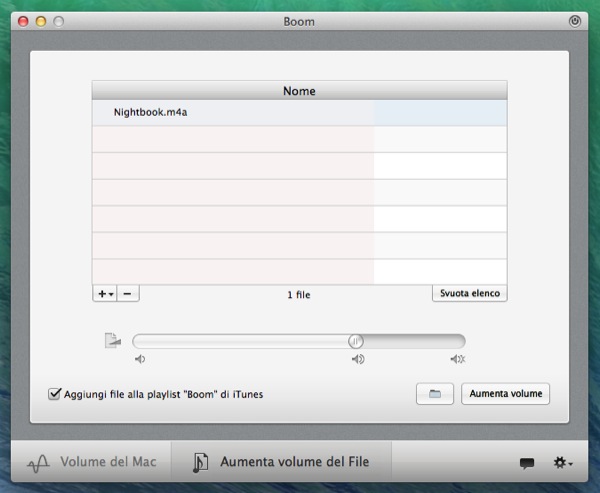

- Boom volume booster mac for mac os x#
- Boom volume booster mac mac os x#
- Boom volume booster mac install#
- Boom volume booster mac software#
Optional final step: If you want the EQ settings to load on every Mac OS X boot, right-click on the AU Lab icon, go to Options, and select “Open at Login” trak EQ file you saved in the previous step Now open AU Lab preferences from the AU Lab menu, click on the “Document” tab and click the radiobox next to “Open a specific document”, selecting the. When satisfied with the EQ settings, hit Command+S to save the EQ settings file and put it somewhere easy to find like the Documents folder Changes here will impact all audio output on the Mac

This is your new system-wide equalizer, set it how you see fit. Now launch AU Lab, found in /Applications/Utilities/įrom the “Audio Input Device” pulldown menu, select “Soundflower (2ch)”, and then from “Audio Output Device” menu select “Stereo In/Stereo Out”Ĭlick the “Create Document” button at the bottom of the screenĪt the next screen, look for “Output 1” column and click the “Effects” dropdown, selecting “AUGraphicEQ” Select “Soundflower (2ch) from the Output list Open System Preferences from the Apple menu and select the “Sound” panel, followed by the “Output” tab. Set System Volume to the maximum level, do this either through the menu bar or by hitting the Volume Up key repeatedly
Boom volume booster mac for mac os x#
Set Up a Universal Audio Equalizer for Mac OS X Once rebooted, follow along with the instructions below:
Boom volume booster mac install#
Soundflower – free download from Google Code ( more recent version here)ĪU Lab – free download from Apple Developers (requires free Apple Dev ID)ĭownload and install both Soundflower and AU Lab, you will then need to restart your Mac to have full access to the audio components. It’s useful if you want to add bumper music or other prerecorded audio to a podcast in real time rather than editing it later, for example, or if you want to bring in audio from a Zoom or Skype call.You can go with custom equalizer and then amplify your sound out Instructions
Boom volume booster mac software#
We didn’t consider these to be freebies in our evaluations because you may already have software you like using, and the appeal of the free software depends on what kinds of music or other content you’re producing.

Included software: All of the audio interfaces we tried include some type of digital audio workstation (DAW) software, as well as various plug-ins (software that produces sound effects or instrument sounds).However, such instruments are increasingly rare, and you can always buy a USB-to-MIDI adapter if the need arises. MIDI connectors: If you use an older keyboard, sampler, or drum machine that doesn’t have a USB connection, you’ll probably want a USB audio interface that has five-pin MIDI connections.If you’re planning to use your audio interface only with a computer in your home studio, this feature is less important. Using a USB audio interface with an iPad, other than those equipped with a USB-C jack, requires the purchase of an extra adapter. But iPads have become a popular tool to capture performances and recordings, so we considered iOS support to be a valuable feature. iOS support: All audio interfaces should support both macOS and Windows, as long as you download and install the appropriate driver.Research shows that the benefits of higher-resolution audio recording (such as 24-bit/192 kHz) are “small and difficult to detect.” You can read more in our article about audio resolution. High-resolution recording: Most USB audio interfaces available today are capable of recording at 24-bit depth with a 96 kHz sampling rate or higher, so we considered that a minimum requirement for our music-oriented picks.It’s important for you to be able to see and read the meters easily. Setting it too low can produce excessive noise and make a recording more difficult to mix. If the level is too high, distortion (often called “clipping”) will result. These meters are critical for setting gain, or record level. Meter design: One of the biggest differences among USB interfaces is in the way their signal-level meters are configured.A well-made interface, even if it’s made of plastic, should survive years of use. Build quality: We immediately dismissed any obviously cheap, flimsy interfaces that looked like they might not survive more than a few months of frequent use.


 0 kommentar(er)
0 kommentar(er)
